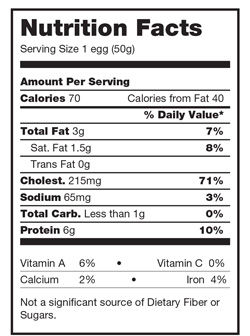
“Cholesterol is not considered a nutrient of concern for overconsumption.”
This one-sentence bullet point appears on one of hundreds of slides created during the series of meetings that took place in the development of the 2015 Dietary Guidelines for Americans—which will be published by the end of the year—but it was enough information for outlets from CNN.com and yahoo.com to TIME.com to The Washington Post to sound the alarm about “big changes” that could be coming in the new Dietary Guidelines.

While this shift in thinking is certainly thought-provoking and, perhaps, controversy-provoking, Natalie Digate Muth, M.D., M.P.H., R.D., FAAP, ACE Senior Advisor for Healthcare Solutions, cautions health and fitness professionals to avoid blowing this news out of proportion. “Science evolves,” says Dr. Muth, “and we’ve known for some time that actual dietary cholesterol isn’t so bad for you.”
There is no better example of the evolving science than the humble egg. It used to be that eggs, which contain more than 200 mg of cholesterol in each yolk, were considered “bad” for you because cholesterol in the bloodstream, especially low-density lipoprotein cholesterol, is associated with an increased risk of heart disease. “But,” says Dr. Muth, “it turns out that consumption of cholesterol from foods does not translate into increased cholesterol in the bloodstream.” The upcoming revision of the Dietary Guidelines is going to reflect that improved understanding.
A related discussion centers on saturated fat. A quick online search uncovers both sides of a dramatic controversy between those who state that there is no link between the consumption of saturated fat and heart disease and those holding the more traditional view that saturated fat should be strictly limited in the diet. There are a number of studies that support the notion that saturated fat is not so bad. The trouble is, headlines and short blogs will have readers believing that eating bacon and butter every day is perfectly healthy.
Others, including the American Heart Association, continue to say that eating a lot of saturated fat increases your chances of getting heart disease—and their official guidelines remain unchanged. In fact, with regard to saturated fat intake, the 2015 Dietary Guidelines for Americans will match the 2010 version, which states that it should be limited to less than 10 percent of total calories.
A GLiMMER of Hope
Dr. Muth recommends that all health and fitness professionals visit www.glimmerinitiative.org, which is an effort to help make sense of nutrition science by focusing on those principles that we know to be true and which are fundamental and, if followed, would provide excellent nutritional health.
A video that appears on the website’s homepage features GLiMMER’s founder David Katz, M.D., M.P.H., explaining the catalyst for its creation and where you, as a health and fitness professional, might fit into this process. “Knowledge isn’t necessarily power,” Dr. Katz says. “There’s something in between that has to translate one into the other.”
That “something” could be you. As the website explains, “Fully 80 percent of all chronic disease and associated premature death around the world is preventable with uncontroversial knowledge we already have.” Health and fitness professionals, while staying within their defined scope of practice regarding nutrition, can be extraordinarily valuable in terms of empowering clients to use that knowledge.
The research on each side of this argument is extensive and beyond the scope of this article, but the important thing here is that you should be aware of the controversy and prepared to answer questions from confused clients.?
How Should You Respond to Shifting Guidelines?
All health and fitness professionals should be familiar with the Dietary Guidelines, which are published every five years and reflect the government’s best advice to Americans on how to eat to promote health. While the guidelines change over time, there are rarely drastic differences from one edition to the next. That said, even minor changes are often seized upon by the media and reported as seismic shifts in thinking.
A statement like “cholesterol is not considered a nutrient of concern” lends itself to misunderstanding and alarmism, particularly when used as a headline. You will likely have clients asking about this, some of whom may even believe that the cholesterol numbers they get from their doctors are no longer a concern, which could not be further from the truth. It’s just that cholesterol in foods is not as closely linked to cholesterol in the bloodstream as was once thought.
Health and fitness professionals should stay on top of health-related news and remain aware of any potential controversies or sources of confusion for their clients. The best tactic would be to tamp down the alarmism and provide a well-considered fact-based response. Remind clients that the scientific process, while sometimes frustrating, continues to check and recheck itself, leading to improved understanding.
By staying educated on these topics, you can position yourself as an expert and reliable resource for your clients. Dr. Muth reminds us that the science isn’t always clear and that nutritional science in particular is in its relative infancy. Combine that with the fact that every individual’s needs are different and everyone’s body is unique and you start to understand why there is sometimes so much confusion.
It’s perfectly understandable why the general public, including many of your clients, is so susceptible to diet fads and trendy headlines. So many of us are so desperate for results that we’re willing to believe almost anything if we think it’s an easier path to looking and feeling better. Can’t you already see the “high-cholesterol heart-healthy diet” on the horizon?
In the long run, the key to good health is balance. And it’s your job to bring the common sense back into a conversation that has so many people running back to foods once declared “unhealthy” the moment they’re given permission to do so by the latest blog post or magazine cover. Trends come and go, but the basics that form the foundation of quality nutrition and good health are as stable as ever.





 by
by 



